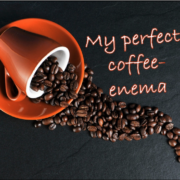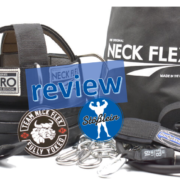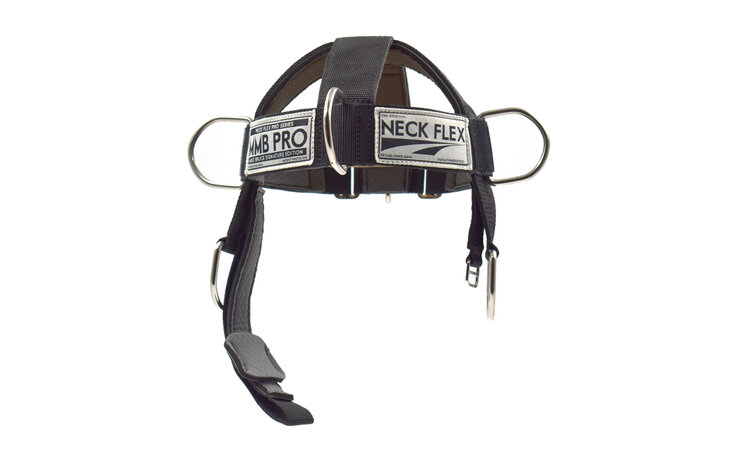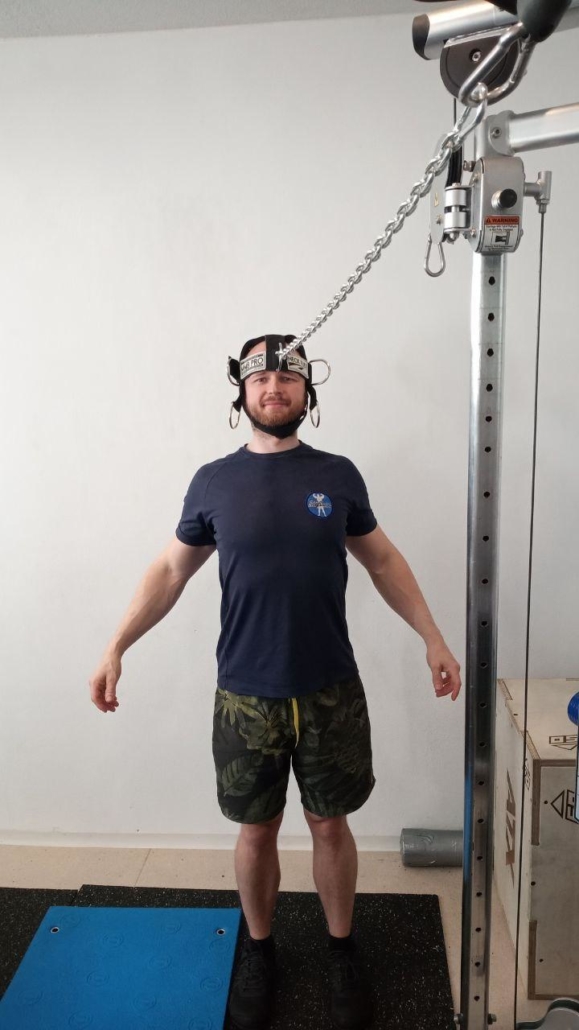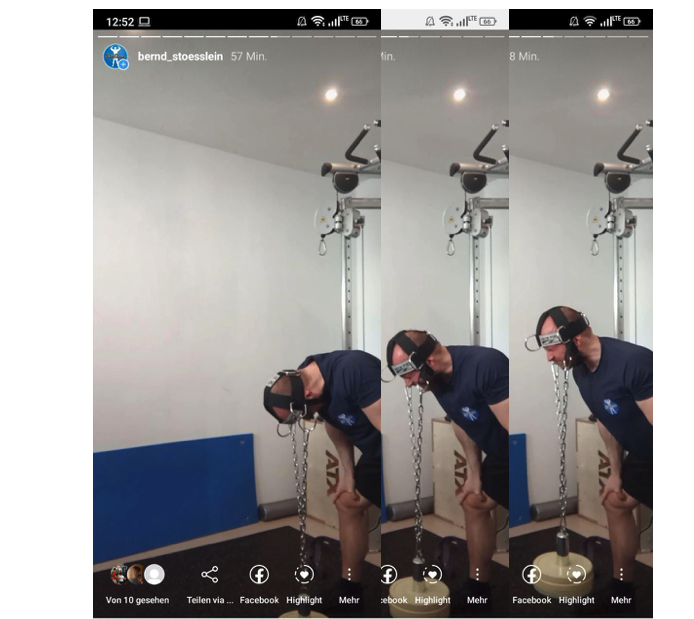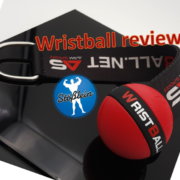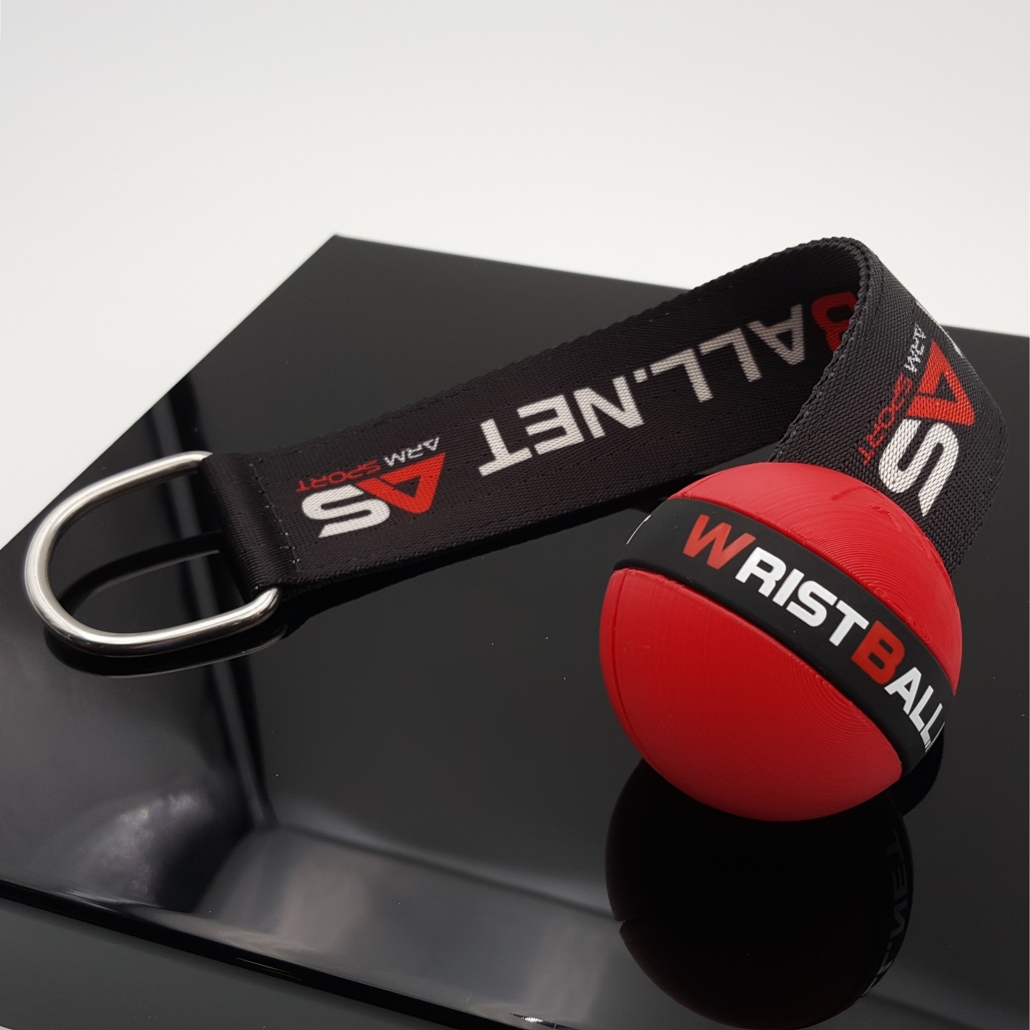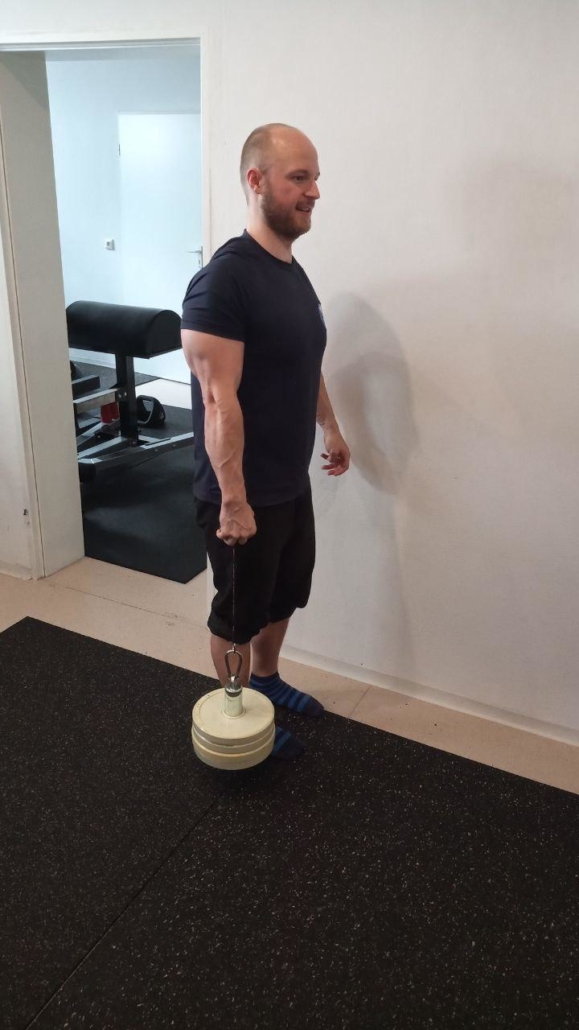Coffee Enema – After reading tons of positives about the effects of enemas, I thought long and hard about trying coffee enemas for myself.
After I initially resisted it and couldn’t really get used to the idea, I then made a “heroic” self-experiment of the effect myself.
After that I felt as pure as never before and my energy level was “superb” all day!
Enemas are by no means a new trend from the “biohacking scene”, but have been used for centuries – if not for millennia – for various purposes.
In this article you will find out why I now swear on (coffee) enemas and how I use them on a regular basis. Don’t worry, there won’t be any explicit pictures of the application 😉 😉
—> THIS ARTICLE IS ALSO AVAILABLE IN GERMAN! <—
Everything You Always Wanted to Know About Coffee Enemas * But Were Afraid to Ask
An enema is called clyster.
This comes from the Greek klysma, klysmatos = intestinal enema or irrigation. The origin of the word is derived from the Greek verb klyzein = rinse, rinse, clean (Becher et al. 1995).
With the enema, the name says it all, different types of fluids can be passed through the anus into the intestine. Anus comes from Latin and means “ring”, because of the ring-shaped muscles in this area (Becher et al., 1995).
Generally, enemas can of course be used with a wide variety of liquids/solutions. Depending on the area of application and objective.
The story of the (coffee) enema
Although enemas have been known and used for thousands of years, the use of the coffee enema is comparatively “new”.

Naturopath (Heilpraktikerin) Ariane Zappe writes in her book (written with co-author Dr. med. Dietrich Klinghardt) “ImmunSymbiose” on the coffee enema, among other things:
“The healing and pain relieving effect of coffee enemas was discovered by chance during the First World War, when, as a result of the occupation of Germany, morphine and other painkillers were no longer available in sufficient quantities. […] Some nurses had the idea of adding the surgeons’ leftover coffee to the enemas. Lo and behold, the soldiers reported an enormous relief and pain relief through this application ”(Zappe and Klinghardt, 2017).
The above quote was translated by myself.
In an article by Dr. Lawrence Wilson, I was even able to find information on somewhat earlier usage. According to that Dr. Wilson writes:
“Coffee enemas have long been in use. In a case report in the Pacific Medicaland Surgical Journal in December 1866, M.A. Cachot, MD, described successful use of a coffee enema to treat a child dying from an accidental poisoning. Articles from the late 1800s reported that coffee enemas were helpful in post-operative care; at a medical meeting in 1896, Dr. W.J. Mayo, one of the founders of the Mayo Clinic, mentioned coffee enemas as a routine part of care for patients after abdominal surgery. Coffee enemas were listed as a stimulant and as a treatment for shock in medical and nursing textbooks in the early 1900s.[…]” (LD Wilson Consultants, Inc., 2019).
On the way to my own coffee enema
Since this article is expressly only an information article, be only my anecdotal experiences are presented here. It is not about healing statements, promises or treatment recommendations. Please note the disclaimer / note at the very end!
The topic of the coffee enema has come across me (July 2019) again and again “by chance” in various kinds of literature. Well, since I don’t believe in “coincidences,” I still believe in the meaning of the word.
So since I got this “in-formation” over and over again, I decided to take a closer look at the topic. Although I could not really get used to the idea of a physical application at first, I was fascinated by the positive qualities, of which I found more and more to read about.
Depending on the literature, I found (partly) overlapping statements, among others at Zappe / Klinghardt, Wilson or Greenfield e.g. over:
Detoxification properties, colon cleansing, pain relief, stimulation of bile production, opening of the bile ducts, vasodilation (vasodilation) of the portal vein circulation, strengthening of glutathione-S-transferase (responsible for removing toxic radicals in blood and serum), stimulation of the organ-nerve system, anti-inflammatory (due to theophyllines & theobromines contained in coffee), etc.
All of this sounds exciting, of course, and made me very curious. The desire for the “heroic” self-experiment grew. After all, you can only report authentically about what you have tried out yourself.
Why do I give myself (coffee) enemas?
At this point I can only speak for myself again, but I am of the opinion that we live in a world that is becoming more and more toxic. It used to be said: “Go out into the fresh air”. But how “fresh” is our air really today?
How pure is food from the sea? How are meat, vegetables and fruits from our fields treated? How many minerals are still in our soils? In my article: “Magnesium chloride -“ legendary ”salt” I go into more detail.
Who can tell me how much – from my point of view – other harmful substances are contained in shampoos, cosmetics, beverages, plastic packaging, dyes, etc.?
Who can honestly tell me how artificial substances will affect my health in the long term?
It is therefore my aim to avoid these substances as far as possible. In particular:
1. Phytoestrogens
2. Mycoestrogens
3. Atrazines
4. Triclosan & APEs (alkylphenols)
5. BP & 4-MBC (Benzophenones & 4-Methylbenzylidene)
6. Red dyes # 3 and # 40
7. Parabens
8. Phthalates
9. BPA & BPS (isphenol A & S)
10. EE2 (17a-ethinylestradiol
This list comes from the book “Estrogeneration” [Affiliate Link], by Dr. Anthony G. Jay. I strongly recommend you to read this book!
In addition, in this world I see myself increasingly confronted with other harmful substances such as:
· Lead
· Mercury
· Cadmium
– Arsenic
Aluminum (nickel)
· Uranium
· Beryllium
· Bismuth
· Antimony
· Zirconium
· Gadolinium
· Tin
· etc.
How can this be tested? Well I do use a device called SO/Check, respectively “Oligoscan”. It uses spectra/photo/metrics to determine the 21 most important minerals, Vitamins and 15 most toxic heavy metals intra- and extracellular.
This is a super-fast, non-invasive method to get an overview of your “toxicity-level”. If you’re interested in getting measured, please consult me over my “Heilpraktiker”-Practice (= Complementary and alternative Medicine Practitioner) in Germany.
Feel free to drop me a mail: info@heilpraktiker-stoesslein.de
Then there are herbicides, fungicides, pesticides, insecticides and certainly thousands of other chemicals. More about the origin of these words and an alternative to “sprayed” vegetables can be found in my article: “Greenunit 2.0 – Your start to the garden in your own four walls?”
Even if I live a healthy lifestyle, these and other substances could still build up in my body. In order to expel these and keep my intestines healthy and functional, I give myself coffee enemas.
Positive effects on me ☯
Through my research on the subject of coffee enemas, I found other positive properties about this procedure. The following has worked for me:
To me, coffee (when used as an enema) seems to have an antioxidant effect. In contrast to other antioxidants, the coffee enema is also said to have a yang effect (Wilson, 2019).
At this point I don’t want to go into the principle of Traditional Chinese Medicine (TCM) of Yin & Yang in detail, because that would fill an entire article. Let me just mention so much for a better understanding:

Yin and Yang are words used to describe opposing forces in nature. Yang means warm, astringent and centripetal. Yin means cold, expanding and having a centrifugal effect.
I am convinced that the balance between Yin and Yang significantly reduces my stress level, contributes positively to my spiritual development, can better drain toxic metals, chemicals, etc. from my body, has a beneficial effect on most of the enzyme reactions in my body and promotes my vitality!
To what extent mediation can be helpful in this process, you can read in my article “Why you should meditate – your thoughts create your reality”.
Own experience:
I can only confirm the alleged Yang effect that coffee enemas have! A 45-minute coffee enema, with constant self-massage of my colon (counterclockwise), was by far the most relaxing thing I have done in the last 30 years!
I can’t say 100% whether it was just the coffee and / or the combination with the self-massage, but I can only underline the YANG effect!
Perhaps the massage simply mechanically stimulated the vagus nerve and thus triggered a parasympathetic (relaxing) effect. Anyway, just fantastic!
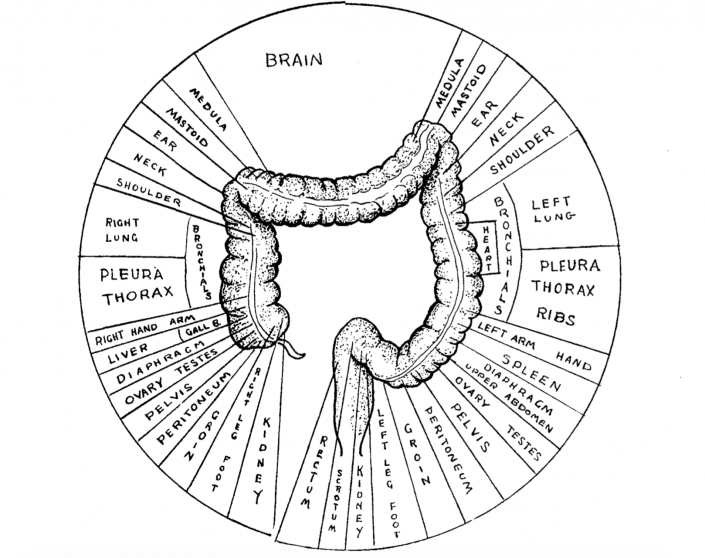
The graphic is from the book: “Iridology Simplified” [Affiliate Link], by Bernard Jensen. Courtesy of Bernard Jensen Healthy Living Publications!
Possible positive effects of coffee (as an enema)
In the course of my research, I have found all kinds of positive aspects about coffee. So Dr. Max Gerson, a big proponent of the coffee enema application, said:
“Heubner and Meyer of Goettingen University, Germany had shown in animal models that rectal administration of caffeine would dilate bile ducts and promote bile flow. Theophylline and theobromine, major constituents of coffee, dilate blood vessels and counter inflammation of the gut. The palmitates of coffee enhance glutathione S-transferase, which is responsible for the removal of many toxins from the blood. Finally, the water in the enema stimulates peristalsis or the movement of toxic substances from the duodenum or upper intestine, through the intestine, and out through the rectum.” (Wilson, 2019).
Palmitic acid
Palmitic acid (Kahweol & Cafesol Palmitate):
“(Hexadecanoic acid) is a saturated organic acid and is counted among the fatty acids (= higher carboxylic acids). Palmitates (systematically also hexadecanoates) are the salts and esters of palmitic acid. Palmitic acid is a colorless solid at room temperature (Wikipedia, 2019).
Zappe writes: “Palmitates in coffee strengthen the so-called glutathione-S-transferase, which are responsible for removing toxic radicals in the blood and serum.” (Zappe, 2017).
As far as I could research, this discovery dates back to the late 1970s and early 1980s and was made by researchers in Lee Wattenberg’s laboratory.
As cited above, palmitates are said to act as potent enhancers of glutathione S-transferase (an important liver enzyme).
Adding coffee beans to the diet of mice increased glutathione S-transferase by 600% in the liver and by 700% in the small intestine. Similar stimulation of glutathione S-transferase in humans by coffee is likely (Wilson, 2019).
Mechanical cleaning
In my experience, a coffee enema cleans my colon by simply “cleansing” it – physically speaking – with the amount of liquid flowed in.
This gives me the feeling that my intestinal villi and microvilli are mechanically cleaned and give me the opportunity to remove toxic substances, parasites, bacteria, yeast colonies and other deposits from me. In this way, I can basically empty all kinds of substances that are not removed otherwise.
Theobromine and theophylline
Theophylline and theobromine are ingredients of coffee types (Lehmann and Martinod, 1965) and tea types (Franzke et al., 1968). They cause vasodilation. (Zappe, 2017). That is, an increase in the diameter of a blood vessel by relaxing the smooth vascular muscles. The term comes from Latin vas = “vessel” and Latin di / latatio from latus = broad, wide, of large size = di / latatio = expansion, expansion (Becher et al., 1995).
When blood vessels expand, blood flow naturally increases in the corresponding area.
You can read more about the “Latin-Greek vocabulary in medicine” in this lexicon or my article: “Latin-Greek vocabulary for personal trainers?”.
Expansion of the biliary tract / “dialysis” through the colon wall?
According to the “Gerson Regimen”, it is believed that the caffeine from the coffee enema either causes a type of “dialysis” of toxic products from the blood via the colon walls or could cause the biliary tract to widen, which in turn could cause the process of removing toxic products from the liver more easyly (Gerson, 1978, 1999).
More N-methylpyridinium from dark roast?
The question arose, of course, about the “optimal” coffee for my enemas. After intensive research and correspondence with Dr. Larry Wilson, who – by his own account – had recommended coffee enemas to over 30,000 people, Dr. Wilson said:
“[…] medium or dark roast, Columbian or at least South American is usually best.“
Dr. Wilson also writes that the nutrients in the soil of Colombia would be best for growing coffee (Wilson, 2019).
However, it could also be decisive that coffee from a dark roast should contain more N-methylpyridinium.
This substance is produced by roasting coffee beans and a “dark roast” should therefore be more effective – compared to a weak, “light” coffee roast – in terms of body fat reduction (through better glucose utilization) and in terms of restoring Vitamin E in red blood cells, and glutathione concentrations (Kotyczka et al., 2011 and Riedel et al., 2014).
I have tested looooots of coffee brands and I currently stuck to Dave Asprey’s “French Kick”, a dark roasted blend from his “Bulletproof” Company. This, btw, is also recommended by Dr. Wilson!
For ME it has proven to use the whole coffee beans and then grind them fresh. For this I use a “Skyline” coffee grinder from WMF [Affiliate Link].
This coffee grinder is not very expensive and you can set the grinding degree differently. This is interesting because you can use it to chop the beans sometimes more and sometimes or less.
Of course, this changes the surface structure of the bean or has an effect on the contact surface between water and bean.
Of course, high-quality coffee also needs to be stored appropriately in order to retain all of its valuable ingredients for as long as possible. For me, the container from Coffee Gator® have been best.
I keep all my coffee beans stored in an airtight container and then prepare them with a so-called “French press”. I also got this from Coffee Gator® because it is made entirely of stainless steel!
This means that microplastic particles cannot dissolve through the hot coffee! Here are my recommendations:
Enema equipment
Of course, for a coffee enema – in addition to a suitable coffee (more on that later) – you also need an enema set [Affiliate Link]. There are different ways of doing this. An enema set consists of an irrigator (either a kind of “bucket” or a bag) and a tube with different attachments (for anal and vaginal rinsing).
Such an enema set [Affiliate Link] was kindly made available to me by the company P. Jentschura [advertising, not paid for] (see picture).
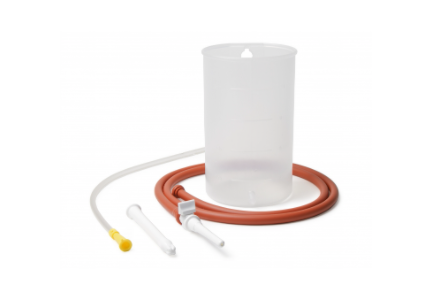
This set consists of the irrigator (in which the inlet liquid is located), an inlet hose, two different attachments and a flexible hose end piece.
I prefer the enema buckets to the bags. One reason for this is the possibility of cleaning. Since the buckets are open at the top, they can be cleaned thoroughly and easily.
There are plastic or glass buckets. But I also use a set made of stainless steel [affiliate link]. Here I would pay attention to the type of metal. As long as it is not stainless steel, there is basically the risk of the metal being oxidized by the coffee!
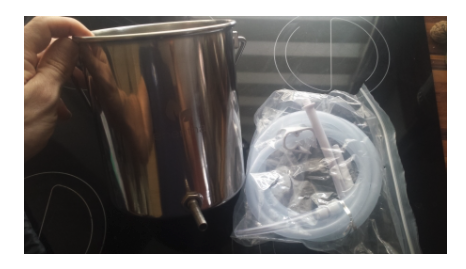
But caution should also be exercised with plastic. Since I don’t want to ingest microplastics, I only pour the coffee into the mug shortly before use (about body temperature; approx. 36/37° C) or use a glass or stainless steel irrigator.
As a big glass lover, I mostly use an irrigator and end pieces for insertion, made of glass. However, these glass enema sets are very difficult to find and certainly at the upper end of the “enema price scale”.
In my opinion, glass has the advantage (when it comes to borosilicate glass) that it is completely free of metals and plasticizers. The glass end pieces for insertion are probably the best choice for people with sensitive mucous membranes.
Of course, you should be careful with glass!
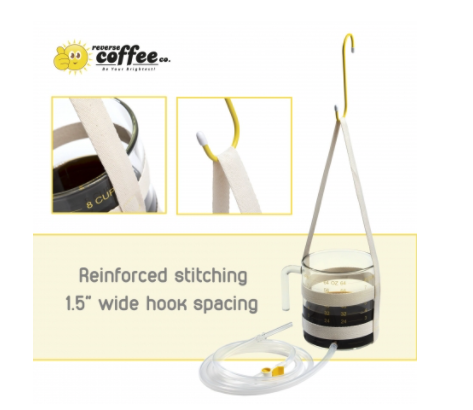
Such a glass “Ultimate Enema Kit” was kindly sponsored by the Australian company: “reverse coffee co” (advertising, not paid). Thank you at this point!
There are two versions of an enema bag – open at the top or closed. The open bag is – equivalent to the bucket – easier to clean because the opening is larger.
Of course, with the large openings there is always the risk that the coffee might pour out. A closed bag is more difficult to clean. I don’t use an enema bag myself.
My enema application
At this point it should be expressly mentioned again that I am only giving MY experience here for information purposes. Anyone who should thereby play with the idea of also giving themselves an enema should definitely consult a naturopath or doctor beforehand.
1. First of all, I only started with a teaspoon of coffee per liter of water (restructured, filtered, ionized) to see how my body reacts to it. Otherwise I don’t drink coffee. In the meantime I use 4 tablespoons of coffee per liter.
2. Before the procedure (usually in the morning on an empty stomach) there was of course a visit to the toilet. Then I drank about 500ml of lukewarm water (filtered, restructured, ionized, enriched with biophotons).
3. Before the enema, I swung on my mini trampoline for 7 minutes
4. I usually do the enema in the bathtub.
5. Basically I stick to the rule that the whole procedure should not cause any discomfort or pain. Otherwise I would abort the process immediately.
6. The boiled coffee (12-14 min) is cooled down to a little below body temperature, approx. 36/37° C.
7. I use commercially available Vaseline [Affiliate Link] but usually better coconut oil [Affiliate Link] both for myself and for the inlet piece.
8. I hang the irrigator on a coat hook on one of the towel rails above the bathtub. I use about 1 liter of water for the enema.
9. When inserting the inlet piece, I lie on my back. But there are other users who swear on other positions, such as a quadruped stand or lying sideways on the left side.
10. When everything is “in place”, either the stopcock of the inlet piece or the hose clamp can be slowly opened (depending on the model). When the liquid rushes in, I think it’s important to relax completely and breathe calmly and deeply.
11. After the coffee has run in slowly and completely, I lie down briefly on my left side and massage my abdomen counter-clockwise to “move the coffee up” in the colon. Then I perform a “candle” position (feet/trunk up in the air) to let the liquid “flow up” according to gravity.
Because of deep abdominal breathing, I don’t feel uncomfortable. Then I usually lie on my back and lift my hips a little (either with a Rumble Roller®) or just put two to three towels under my hips.
12. I then hold the enema for at least 15 minutes, up to max. one hour. Optionally, I also use my so-called “Gou Gong® – China Lamp” to provide even more relaxation in my stomach area through its infrared heat and minerals from its clay plate.
At the end you have to go to the toilet for emptying, of course always with your feet raised on a stool / “Squatty Potty” [Affiliate Link], so that the bowel can empty itself completely!
You can find out more about it here. When emptying, I rub my right calf, below the hollow of the knee. An acupressure point from TCM that is supposed to stimulate the emptying (seems to work for me!)
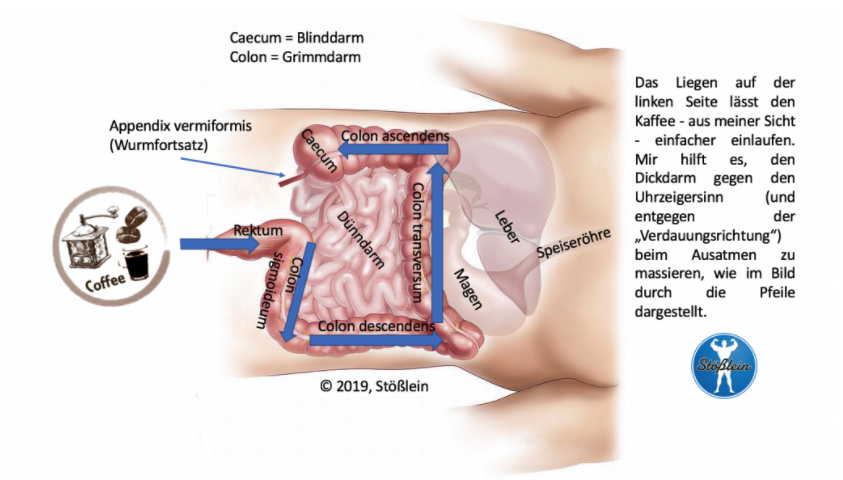
13. For me, the meal after the enema is mostly also a “yang meal”, usually eggs with cooked vegetables from my own garden (no tomatoes, as these should have a “YIN effect”).
If I don’t want to consume a solid meal after the enema not to stress my digestive system again, then I drink, for example just 250ml of water (see above), with a teaspoon of “Ambro Greens” [Affiliate Link].
With regard to the frequency, there are different statements in the literature, from up to 4-6 enemas per day. I think that it depends a lot on the duration of use. I myself prefer only one enema a day / morning and I keep it up to 60 minutes.
In theory, one could perform 4 x 15 minute enemas. For reasons of time efficiency, I prefer an application of up to 60 minutes.
Since the enema is supposed to have a “yang effect”, for me the relaxing effect is most important. Carrying out a hectic and hasty procedure four times would – from my point of view – be rather counterproductive.
Enema breathing technique
Now I’m going to demonstrate a breathing technique called Oxygen Advantage®. As a certified Oxygen Advantage Coach, I use this breathing technique not only during the entire enema procedure, but also in everyday life, e.g. activation of the parasympathetic nervous system.
1. Either lying on the floor or in the bathtub
2. Optionally small Rumble Roller® (RR) [Affiliate Link] with towels under the hip
3. Towel rolled up under the head (keep the cervical spine in a natural position, no pillow / towel that is too high)
4. Soles of feet together (when lying in the bathtub), diamond shape, when lying on the floor, legs upright
5. Breathe in for 4 seconds (diaphragmatic breathing), breathe out for 6 seconds
6. Place your hands either folded below the navel or next to your torso / buttocks
7. Repeat
8. During the application I use so-called “Binaural Beats” (affiliate link), for (my) optimal relaxation, preferably in the theta brain wave range. For listening to them, I use special headphones with pneumatic sound transmission (affiliate link). Why I use them can be read about my EMF optimization in my article.
9. I also like to use red and infrared light during my enema. You can read more about this in my articles on so-called photobiomodulation.
Why not just drink coffee?
Now one or the other might ask the quite legitimate question, why not just drink the coffee instead of giving yourself an enema ?!
The main difference is probably the way the body absorbs the coffee. While coffee that is taken orally has to pass the stomach before it first reaches the small intestine, coffee that is taken rectally reaches the large intestine (colon), see picture above.
Dr. Wilson states:
“The colon seems to block the absorption of certain toxins found in coffee, including cadmium and some of the caffeine. Drinking one cup of coffee daily is okay, but not recommended. Drinking more than one cup is harmful for most people.” (Wilson, 2019).
Of course you can argue about the toxicity of drunk coffee and from my point of view, a different dose decides for each individual when to becomes toxic.
That depends to a large extent on the quality of the coffee. As with coffee for drinking, I would only use organically grown coffee for the coffee enema, which is free of impurities, chemicals, pesticides, etc.
But even the best coffee – like all other substances in the world – will contain traces of toxins. That is why the dose decides when something becomes toxic.
Coffee can e.g. contain some toxic metals like lead and cadmium as well as some toxic alkaloids.
Ground coffee can also be rancid because it contains polyunsaturated oils that can go rancid quickly.
“(…) from our experience, when taken by rectum, these toxins are not absorbed nearly as much as when the coffee is taken orally.This occurs because the colon is designed to absorb nutrients, while filtering out and leaving behind toxic substances inside the colon. In fact, a healthy colon is quite amazing in its ability to absorb nutrients while protecting the body from a wide variety of toxic substances. This is the reason why drinking coffee is somewhat toxic, but coffee used in an enema is much less so. In fact, we have seen very little toxicity from repeated coffee retention enemas, while those who drink coffee regularly exhibit some toxicity from the beverage.” (Wilson, 2019).
My thoughts on increased fat burning
From a subjective point of view, through the use of regular (daily use) enemas, I have the feeling that I am also seeing increased body fat burning. Especially in the area of the lower abdomen, which is quite stubborn even through good nutrition and exercise.
At this point it should be said that this is not a guide on how to lose weight or get rid of body fat through coffee enemas alone. Bad eating and exercise habits cannot be outdone with coffee enemas.
I am only reporting here on my own experience. I could explain a stronger body fat burning by increased liver activity, added caffeine, N-methlypyridinium in coffee (from dark roast) and by an accelerated metabolism. Information without guarantee, of course!
Coffee enema with DMSO?
The idea of combining a coffee enema with dimethyl sulfoxide (DMSO) came from colleague Dr. rer. nat. Hartmut Fischer. He writes regarding the addition of DMSO in enemas:
“If it is rather small enema quantities of up to 500 ml, so I definitely add the full 15% DMSO. At 500 ml, that would be a maximum of 75 ml. For even larger volumes than 500 ml, I leave this 75 ml DMSO as an additive. ” (Fischer, 2020).
I myself add 75 ml to the approximately one liter of liquid that I use for my coffee enema and have no problems with it.
The only side effect lies in the smell (which I don’t smell myself) that I evaporate after the enema (caused by the DMSO).
DMSO has, in a nutshell, e.g. pain- and anti-inflammatory properties, has a cell-protecting and regenerating effect and is part of the new formulation of the German Drug Code (Rezeptformularium des Deutschen Arzneimittelkodex).
FeetUp®, Inversion & the coffee enema
To better distribute the coffee enema in the intestine, you can of course use the gymnastics exercise of the “candle”.
If you want to achieve a better inversion, you can also use an inversion table (a detailed article on this topic can be found here).
Since an inversion table would probably be too bulky for most bathrooms, I discovered the following alternative for myself: A so-called FeetUp® (unpaid advertising).
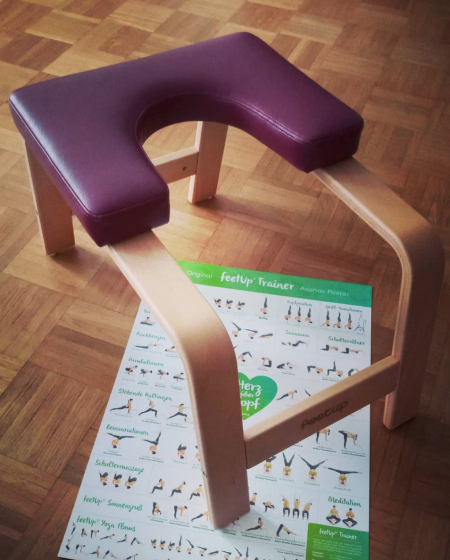
How do I clean my enema kit?
Every now and then people seem to like to use an enema set that is particularly dangerous for introducing germs, viruses or other things into the intestine.
This is completely incomprehensible to me, since – from my point of view – it is self-evident that the principles of hygiene are also observed in the context of this application.
Enema utensils that are in use should therefore always be appropriately disinfected before and after use, and the enema nozzles should only be used individually and not be shared with other people!
When choosing the disinfectant, everyone can choose his/her favorite agent again. Common alcohol-based products are available in every drugstore and / or pharmacy.
I prefer to use a 3% hydrogen peroxide (H2O2) solution for myself. This is also available from the aforementioned sources.
Coffee Enema Conclusion
I don’t want to make this article too long, which is why I will draw my conclusion:
It was “coincidence” that I stumbled upon the topic of the coffee enema. I couldn’t and didn’t want to ignore that, so I got into this interesting topic.
Since it is well known that trying is more important than studying, a self-experiment was inevitable. Because only those who have tried something can report authentically.
After the mental and physical inhibitions had been overcome, the positive effects reported above also appeared. I can definitely confirm the relaxing yang effect! At least in my experience.
After a coffee enema, I always feel clean as a whistle and super energetic throughout the day.
From a therapeutic point of view, the positive effects mentioned by Zappe, Wilson, Gerson and other sources clearly make sense to me.
I corresponded with Dr. Wilson by email. You can find his extremely detailed article on coffee enemas here.
© HP Bernd Stößlein, Master of Business Administration in Sports Management.
If you liked this article, then subscribe to the blog / newsletter, leave a comment or contact me.
In this and other articles you will find one or the other “affiliate link” to amazon. If you purchase something through this link, you will support my blog articles and create resources for further high-quality research and articles like this. There are no additional costs for you! You can find all of my basic recommendations at: https://www.amazon.de/shop/bernd_stoesslein
Sources/Literature
Lateinische griechischer Wortschatz in der Medizin, 1995, S. 39.
Lateinische griechischer Wortschatz in der Medizin, 1995, S. 112.
Lateinische griechischer Wortschatz in der Medizin, 1995, S. 242.
Ariane Zappe und Dr. med Dietrich Klinghardt, ImmunSymbiose, 2017, S. 285 f.
Coffe Enemas, Dr. Lawrence Wilson, LD Wilson Consultants, Inc., Quelle: https://www.drlwilson.com/articles/COFFEE%20ENEMA.HTM#CH1, Zugriff v. 23.7.19.
Detusches Wörterbuch von Jakob und Wilhelm Grimm, 16 Bde. in 32 Teilbänden. Leipzig 1854-1961. Quellenverzeichnis Leipzig 1971, Bd. 32, Sp. 342 bis 34.
The Kion Coffee Enema: Everything You’ve Always Wanted To Know About Coffee Enemas (But Were Afraid To Ask), Quelle: https://bengreenfieldfitness.com/article/digestion-articles/kion-coffee-enema/, Zugriff v. 23.7.19.
Coffee Enemas, by Dr. Lawrence Wilson, LD Wilson Consultants, Inc., Quelle: https://www.drlwilson.com/articles/COFFEE%20ENEMA.HTM, ZUgriff v. 26.7.19.
Palmitinsäure, Wikipedia, Quelle: https://de.wikipedia.org/wiki/Palmitinsäure, Zugriff v. 26.7.19.
Lehmann G; Martinod P. Über Das Vorkommen Von Theobromin Im Kaffee. Hoppe-Seyler’s Zeitschrift Fur Physiologische Chemie 1965, 341 (1), 155–156.
Franzke C; Grunert KS; Hildebrandt U; Griehl H. Zum Theobromin- Und Theophyllingehalt von Rohkaffee Und Tee. Die Pharmazie 1968, 23 (9), 502–503.
Gerson Therapy Handbook : Practical Guidance, Resources, and Recipes for Following the Gerson Therapy, Rev. 5th.; Gerson Institute: Bonita, Calif., 1999.
Gerson, M. A Cancer Therapy : Results of Fifty Cases ; and, the Cure of Advanced Cancer by Diet Therapy : A Summary of 30 Years of Clinical Experimentation, Sixth.; Gerson Institute: San Diego, CA, 2002.
Jensen, B. Iridology Simplified : An Introduction to the Science of Iridology and Its Relation to Nutrition, 5th ed.; Healthy Living Publications: Summertown, TN, 2011.
Kotyczka C; Boettler U; Hofmann T; Lang R; Marko D; Stiebitz H; Bytof G; Lantz I; Somoza V. Dark Roast Coffee Is More Effective Than Light Roast Coffee in Reducing Body Weight, and in Restoring Red Blood Cell Vitamin E and Glutathione Concentrations in Healthy Volunteers. Molecular Nutrition and Food Research 2011, 55 (10), 1582–1586 DOI: 10.1002/mnfr.201100248.
Riedel A; Hochkogler CM; Lang R; Bytof G; Lantz I; Hofmann T; Somoza V. N-Methylpyridinium, a Degradation Product of Trigonelline Upon Coffee Roasting, Stimulates Respiratory Activity and Promotes Glucose Utilization in Hepg2 Cells. Food & Function2014, 5 (3), 454–462 DOI: 10.1039/c3fo60320b.
Fischer Hartmut, DMSO-Rundbrief, Zitat entnommen aus: “DMSO & Co. Medizin zum Selbermachen – Dr. Fischer’s Rundbriefe 2017-2020”, Praxisinstitut Naturmedizin, 2020.

